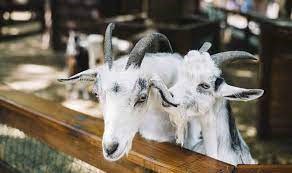ABOUT GOAT REARING
Back
History of Goat Farming
Goats are among the earliest animals domesticated by humans. The most recent genetic analysis confirms the archaeological evidence that the wild bezoar ibex of the Zagros Mountains is the likely original ancestor of probably all domestic goats today.


Neolithic farmers began to herd wild goats primarily for easy access to milk and meat, as well as to their dung, which was used as fuel; and their bones, hair, and sinew were used for clothing, building, and tools. The earliest remnants of domesticated goats dating 10,000 years Before Present are found in Ganj Dareh in Iran. Goat remains have been found at archaeological sites in Jericho, Choga Mami, Djeitun, and Çayönü, dating the domestication of goats in Western Asia at between 8,000 and 9,000 years ago.
Studies of DNA evidence suggests 10,000 years BP as the domestication date. Historically, goat hide has been used for water and wine bottles in both traveling and transporting wine for sale. It has also been used to produce parchment.
Origination of goat
Beginning between 10,000 and 11,000 Before Present (BP), Neolithic farmers in areas of the Middle East and Western Asia started keeping small herds of ibexes for their milk and meat; dung for fuel; and hair, bone, skin, and sinew for clothing and building materials. Domestic goats were recognized archaeologically by:


• Their presence and abundance in regions well beyond western Asia.
• Perceived changes in their body size and shape (morphology).
• Differences in demographic profiles from feral groups.
• Stable isotope evidence of dependence on year-round fodders.
Archaeological data suggests two distinct places of domestication: the Euphrates river valley at Nevali Çori, Turkey (11,000 BP), and the Zagros Mountains of Iran at Ganj Dareh (10,000 BP). Other possible sites of domestication posed by archaeologists included the Indus Basin in Pakistan at (Mehrgarh, 9,000 BP), central Anatolia, the southern Levant, and China.
Standings of India and states in the World for goat milk, meat and Population

97.2 million Goats Slaughtered for Meat Production
27.74 per cent Distribution of goat in Total Livestock as per 20th Livestock Census
Largest livestock population - Uttar Pradesh
3 per cent Goat Milk Contribution to Total Milk Production in India
13.35 per cent goat Meat Contribution to Total Meat Production in India
Highest goat meat production - West Bengal
Highest goat milk production – Rajasthan
Highest goat population - Rajasthan
Total Goat Population in the country is 148.88 Million during 2019.
Total Goat has increased by 10.14% over previous Livestock Census (2012).
About 27.8% of the total livestock is contributed by goats.
Goat Population - Male, Female and Milch

Goat Population 2012 & 2019 of Major States

• 20th Livestock Census (2020). DADF, DADF, Ministry of Fisheries, Animal Husbandry & Dairying, GoI.
• Three Year Export Statement, APEDA. Retrieved from https://agriexchange.apeda. gov.in/indexp/ExportStatement.aspx on 21.05.2020.
• Basic Animal Husbandry & Fisheries Statistics (2019). Animal Husbandry Statistics Division, DADF, Ministry of Fisheries, Animal Husbandry & Dairying, GoI.
